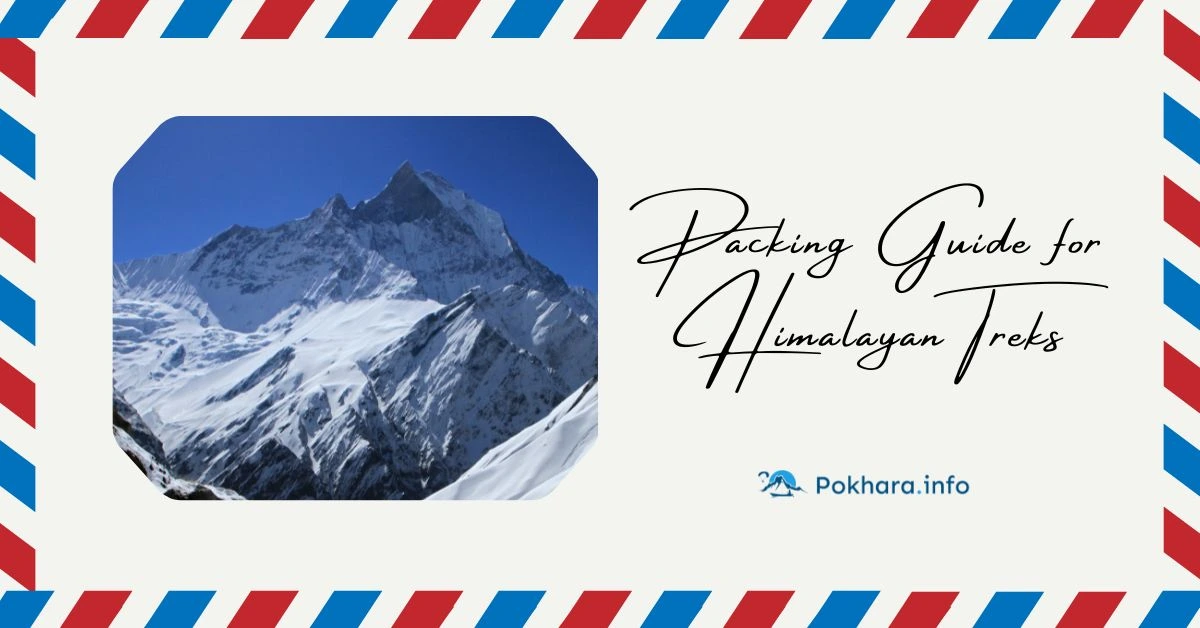From crossing Thorong La Pass to exploring the windy Mustang plateau, or from trekking the remote Dolpo valleys to the Himalayas, demand strategic packing.
Conditions can swing from hot, dusty trails at 3,000 m to freezing blizzards at 5,400 m, and your packing guide for Himalayan treks must cover every possible scenario.
This master guide is divided into:
Packing Philosophy & Approach
Core Gear Essentials
Clothing Layer System
Footwear & Socks
Accessories & Personal Items
Seasonal Adjustments
Ultra-Lightweight vs Comfort-Oriented Lists
Pro Tips for Organizing & Carrying Gear
Packing Philosophy & Approach
Your packing decisions should consider:
Carrying Method: Self-carry or with porter/mule support
Season: Autumn & spring = moderate cold, Winter = extreme cold, Monsoon = rain & leeches
Region Terrain: Mustang/Dolpo = dry, dusty, remote; Annapurna/Manang = mixed forests, snow passes
Style: Minimalist trekking vs comfort trekking
Golden Rules
Layer, don’t load, bring multiple thin layers instead of one bulky piece
Multi-purpose everything, e.g., a buff that doubles as a mask, headband, and sun protection
Weatherproof your pack, double rain cover, and internal dry sacks
Emergency self-sufficiency, be able to survive 24 hrs in bad weather without outside help
Core Gear Essentials
(Every trekker, every route, every season)
Backpack
Self-carry trekkers: 35-45L ultralight trekking pack (with padded hip belt, ventilation frame, 800-1200g weight)
With porter: 50-60L expedition pack (strong frame, rain cover, side pockets)
Sleeping System
Sleeping bag:
Autumn/Spring: Down bag comfort -5°C
Winter or Dolpo: Down bag comfort -15°C to -20°C
Always with compression sack & liner (fleece or silk)
Optional: Inflatable pillow (lightweight), or stuff sack with clothes as pillow
Trekking Poles
Adjustable (carbon fiber for lightness or aluminum for durability)
Anti-shock feature helps on descents
Hydration
1-2 L rigid bottles (e.g., Nalgene) and/or collapsible bottles/bladders
Water treatment: Chlorine dioxide tablets, or portable filter (Sawyer/Steripen)
Insulating bottle cover for high passes (prevents freezing)
Clothing Layer System
The Layering Rule:
Base layer (moisture control), then, Mid layer (insulation), then, Outer shell (protection).
Base Layers (Against Skin)
Upper:
1 lightweight merino wool long-sleeve (odour resistant)
1 synthetic quick-dry long-sleeve (for warmer days)
Lower:
1 thermal bottom (merino or synthetic) for nights & passes
1 lightweight trekking pant (convertible to shorts, optional)
Underwear:
2-3 pairs synthetic or merino (avoid cotton)
Sports bras for women (quick-dry)
Mid Layers (Insulation)
Fleece jacket: Midweight 200 gsm fleece with full zip
Optional: Synthetic insulated vest for mornings/evenings
Down/synthetic jacket:
Autumn/Spring: Lightweight down (comfort -5°C)
Winter/Dolpo: Heavy expedition down (-15°C)
Outer Shell (Weather Protection)
Waterproof jacket: 3-layer breathable membrane (e.g., Gore-Tex) with pit zips
Waterproof pants: Full side zips for wearing over boots
Footwear & Socks
Trekking boots:
Waterproof-breathable membrane (e.g., Gore-Tex)
Mid-ankle or high-ankle for support
Well broken-in before trek
Camp shoes: Lightweight sandals or down booties (Dolpo/winter)
Socks:
3 pairs of merino wool trekking socks
1–2 pairs thin liner socks (reduces blisters)
1 pair thick thermal socks (for sleep & high passes)
Accessories & Personal Items
Headwear:
Sun hat with brim
Warm beanie (fleece or wool)
Buff/multifunctional headwear
Balaclava for high winds
Gloves:
Thin fleece gloves
Insulated waterproof gloves/mitts
Overmitts in extreme cold
Eye protection: Category 3 or 4 UV sunglasses (glacier glasses for snow glare)
Headlamp: LED, 100+ lumen, with spare batteries
Gaiters: For snow or dust protection
Microspikes/traction devices: If trekking in winter or early spring
Seasonal Adjustments
Autumn (Oct-Nov)
Moderate cold, clear skies
Standard 3-layer system works, lightweight down fine
Winter (Dec-Feb)
Extreme cold (-20°C in passes)
Heavy down, expedition sleeping bag, insulated boots, more mid-layers
Spring (Mar-Apr)
Warm lower altitudes, cold passes
Light rain possible so add packable rain jacket & pants
Monsoon (Jun-Aug)
Heavy rain, leeches below 3,000 m
Quick-dry synthetics, leech socks, full rain set, avoid down (use synthetic insulation)
Ultra-Lightweight vs Comfort-Oriented Packing
Ultra-Lightweight (Self-Carry)
7-10 kg
Minimal spare clothes
Multi-use gear
Lightweight down (-5°C)
Small first-aid & electronics kit
Eat at tea houses, no cooking gear
Comfort-Oriented (With Porter)
14–20 kg
Spare clothing for hygiene & emergencies
Heavy down (-15°C)
Larger first-aid kit, extra snacks, and reading material
Bigger sleeping bag & pillow
Optional camping gear for remote Dolpo/Mustang
Pro Tips for Packing
Dry bags inside the backpack protect from the Himalayan dust and snow
Pack by frequency, quick-access pocket for rain jacket, water, snacks
Foot care kit, blister pads, tape, nail clipper
Clothes washing, small biodegradable soap, cord for drying
Energy boosts, carry 1–2 “emergency morale” snacks (chocolate, dried fruit)
Weather redundancy, always have one extra dry warm layer sealed in a ziplock
Sample Ultra-Light Pack List for Autumn Annapurna Circuit
35L pack
Down jacket (-5°C)
2 base layers (top), 1 base bottom
1 fleece, 1 rain jacket & pants
1 trekking pant
2 merino socks, 1 liner sock
Light gloves, beanie, buff
Boots + sandals
1 sleeping bag (-5°C) + liner
Headlamp, water bottles, filter tabs
Minimal toiletries, first-aid kit, phone + map app
Sample Comfort-Oriented Pack List for Winter Dolpo
60L pack (carried by porter)
Heavy down (-15°C)
3 base tops, 2 base bottoms
Fleece + synthetic vest
Waterproof 3-layer shell
2 trekking pants + 1 insulated pant
5 merino socks + thermal socks
Liner gloves + insulated mitts + over-mitts
Boots + down booties
Sleeping bag (-20°C) + pillow
Headlamp + spare batteries
2L bottles + pump filter
Expanded first-aid kit, toiletries, comfort snacks
Camera, power banks, solar charger

